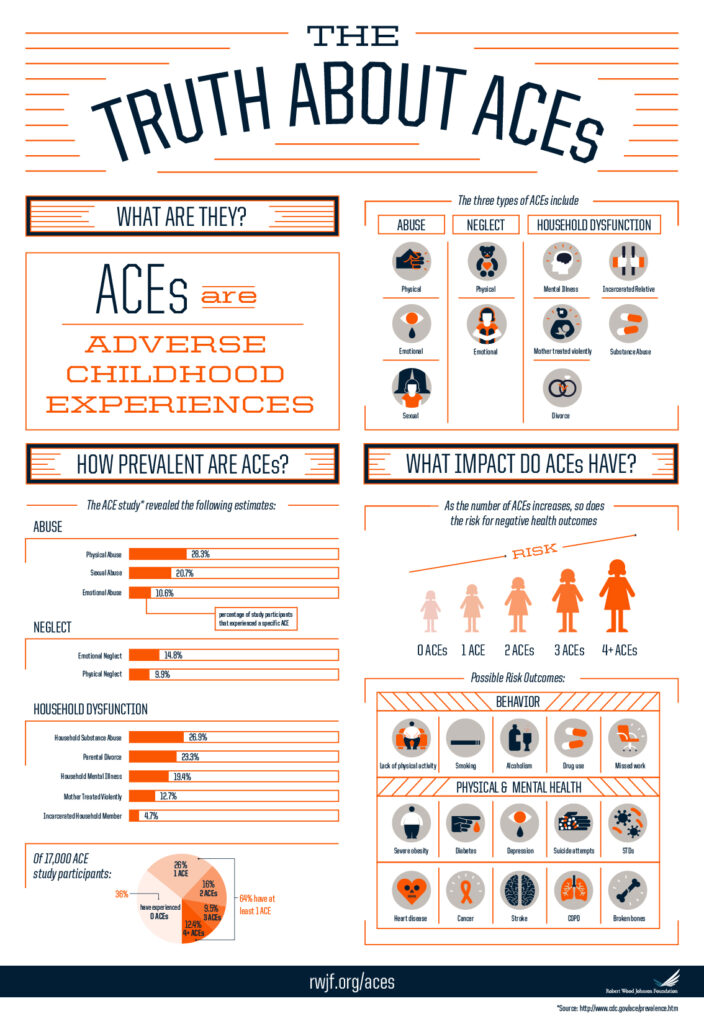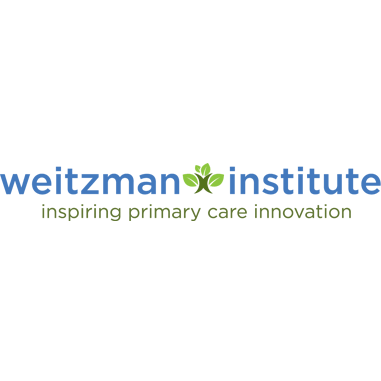Social Determinants Of Health
Adverse Childhood Experiences
Adverse childhood experiences (ACEs), which are defined by the Centers for Disease Control and Prevention as potentially traumatic events that occur in childhood (0-17 years), are a major public health problem in the United States.
ACEs disproportionately impact marginalized communities, including low-income populations and communities of color. Subsequently, examining and addressing ACEs is a key component of our equity-driven research agenda.

The Truth About ACEs Infographic by RWJF on RWJF.org
Featured Work
Abstract
Although numerous studies have examined the relationship between adverse childhood experiences (ACEs) and suicide, research is needed that studies the effects of specific ACEs, including subclasses of ACEs, independent of the effect of other ACEs. We explored the relationship between ACEs and suicidal ideation (SI) with special attention to patterns according to generation cohort (millennials: 22–37 years old, generation X: 38–53 years old, and baby boomers: 54–72 years old), and assessed the extent to which mood and anxiety disorders account for the relationship between ACEs and suicidal ideation. Patients in behavioral healthcare services of a large federally qualified health center (n = 4,392) were assessed at baseline on ACEs, SI, and mood and anxiety disorders. Logistic regression modeling was used to examine the data. Emotional neglect was the strongest predictor of SI among Millennials (OR = 1.59), Generation X (OR = 1.81), and Baby Boomers (OR = 1.88) after controlling for mood and anxiety disorders, race/ethnicity, and gender. Findings suggest ACEs predict an increased likelihood of having SI over and above the influence of mood and anxiety disorders, in models adjusted for gender and race/ethnicity. Across generations, the association with suicidal ideation was strongest for any child abuse and neglect, but not for household dysfunction. The observed association of ACEs with suicidal ideation suggests that ACEs should be considered as a risk factor and incorporated into screening assessments for suicidal ideation. Lastly, additional research on the association of ACEs and suicidality in individuals not actively being managed in behavioral healthcare settings is also warranted.
Citation: Damian AJ, Oo M, Bryant D, Gallo JJ (2021) Evaluating the association of adverse childhood experiences, mood and anxiety disorders, and suicidal ideation among behavioral health patients at a large federally qualified health center. PLoS ONE 16(7): e0254385. https://doi.org/10.1371/journal.pone.0254385
Abstract
Adverse childhood experiences, which is defined by different forms of abuse, neglect, and household dysfunction occurring before the age of 18 years, is a major public health problem in the United States that has the potential to worsen in the current COVID-19 pandemic. Moreover, the challenge is even greater for children and youth from low-income communities and communities of color. Thus, there is a greater need for investments in youth-serving systems within and beyond health care and public health to effectively address adverse childhood experiences and prevent its short- and long-term negative health and social sequelae well beyond the current public health crisis.
Citation: Bryant D, Oo, M, Damian, AJ (2020). The rise of adverse childhood experiences during the COVID-19 pandemic. Psychological Trauma: Theory, Research, Practice, and Policy, 12(S1), S193–S194. https://doi.org/10.1037/tra0000711
Background
Adverse childhood experiences (ACEs) and substance use disorders (SUDs) are highly prevalent public health challenges that have been shown to be strongly correlated. Although previous research has suggested a dose-response relationship between ACEs and SUDs, less is known about this phenomenon and the prevalence of ACEs in lower income, racially/ethnically diverse populations. This study sought to examine these relationships in a population treated at a multi-site safety net provider.
Methods
The ACEs survey was delivered as a standard assessment to all behavioral health patients seen at a large Federally Qualified Health Center (FQHC) in Connecticut. 4378 patients completed the questionnaire. Both total score and individual ACE questions were correlated with diagnostic history, according to chi-square and multiple-group structural equation modeling tests.
Results
84.8% of patients reported at least one ACE and 49.1% had an ACE score ≥ 4. Experiencing 1 or more ACEs predicted having any SUD, after controlling for race/ethnicity and gender. Parent substance use, physical abuse, and sexual abuse in particular were the strongest predictors of developing any SUD. Men and non-white individuals were more likely to develop an SUD with lower ACE scores than women and white individuals.
Conclusions
While ACEs predict an increased likelihood of developing any SUD, the nature of this relationship differs by both gender and race/ethnicity. In this FQHC patient population there is no obvious dose-response relationship between ACEs and SUDs. Additional research is required to help understand why the relationship between ACEs and SUDs observed here differs from other populations.
Citation: Bryant DJ, Coman EN, Damian AJ (2020). Association of adverse childhood experiences (ACEs) and substance use disorders (SUDs) in a multi-site safety net healthcare setting. Addictive behaviors reports. 12:100293. https://doi.org/10.1016/j.abrep.2020.100293
Housing Instability
Housing instability is a major public health challenge facing 4.2 million youth across the U.S., and disproportionately affecting LGBT and youth of color. Nonetheless, early actions to intervene can help boost resilience and change the life trajectories of homeless youth. School based health centers (SBHCs) in particular, can serve a vital role in actively addressing the health and health-related social needs of youth experiencing housing instability, including serving as the gatekeeper to community-based supports.
Community Health Center, Inc. (CHCI)/Weitzman Institute, as one of the largest Federally Qualified Health Center (FQHC) sponsors of school based health centers in the country and the leading sponsor in the state of Connecticut, is facilitating a youth-driven policy and research project led by Dr. April Joy Damian, to better understand the factors contributing to housing instability among youth with a particular focus on New Britain, Connecticut given the significant health and social disparities in this community.
CHCI/Weitzman leverages its longstanding partnerships with youth-serving organizations (YSOs) to examine barriers and facilitators YSOs encounter in addressing the health and health-related social needs of youth experiencing housing instability. Key deliverables from this work will include youth-driven solutions and policy recommendations for effectively addressing the health and health-related social needs of this population through youth-led multimedia advocacy activities and a series of policy briefs.
Please refer to the Policy section of our website for more details about our efforts in this area.
Gender-Based Violence
Featured Work
- Biroscak BJ, Castillo D, Guzdek G, & Huang J (2021, September 22-24). Sex Trafficking Dynamics: Results from a Service-Learning Course Student Project in Connecticut [Conference Presentation]. 18th International Human Trafficking and Social Justice Conference, Toledo, OH, United States. https://app.traffickingconference.com/schedule/229
- Biroscak BJ, Harding K, Bryant D, Oberoi P, SanGiovanni L, McCall-Hosenfeld J, Murphy E, & Blankson M (2021). The Critical Role of Frontline Workers for Helping Intimate Partner Violence Victims in Safety-Net Settings. Violence & Victims, in revision.
- Agrawal P, Post L, Glover J, Hersey D, Oberoi P, & Biroscak BJ (2021). The Interrelationship Between Food Security, Disasters, and Gender-Based Violence. PLOS Global Public Health, under review.

